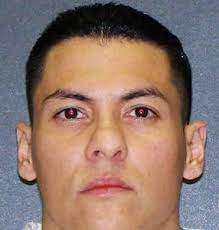Martin Robles was executed by the State of Texas for two murders
According to court documents Martin Robles, who served a juvenile sentence for murder, would shoot and kill two nineteen year olds, Jesus Omar Gonzalez and John Commisky, while they were asleep with an automatic rifle
Martin Robles would be arrested, convicted and sentenced to death
Martin Robles would be executed on August 10 2011 by lethal injection
Martin Robles Photos

Martin Robles FAQ
When Was Martin Robles Executed
Martin Robles was executed on August 10 2011
Martin Robles Case
Convicted killer Martin Robles was executed Wednesday evening for the shooting deaths of two young men nearly nine years ago who belonged to a rival street gang in Corpus Christi.
Robles, 33, had little to say from the gurney. Asked by the warden if he had a final statement, he replied: “I love Israel.”
He took several deep breaths as the lethal drugs began flowing into his arms, then began snoring. Within a minute, his breathing stopped.
He was pronounced dead at 6:21 p.m., nine minutes after the drugs started. He had exhausted his appeals and no late court actions to try to spare him were made as his lethal injection neared.
There were no relatives or friends to watch him die. Prison officials said he had removed all names from his list of visitors, refused a phone call earlier Wednesday from a relative and declined make a final meal request. No representatives of his victims were present in the death chamber.
Robles became the ninth prisoner executed in Texas this year. Another four are set to die next month.
Robles had a lengthy criminal record as a juvenile, then was convicted of murder when he was 17 and sentenced to six years in prison. He had been out of prison about a year after serving the full sentence when he was arrested for the November 2002 shooting that killed two 19-year-olds, Jesus Omar Gonzalez and John Commisky.
Evidence showed Robles, who dropped out of school after the eighth grade, belonged to a gang called the Raza Unida, or “RU,” that was squabbling over drug-dealing turf and feuding violently with another gang that counted the victims as members.
Testimony at his trial showed Robles and a companion put on dark clothing and masks before dawn on Nov. 12, 2002, climbed a fence and entered the Corpus Christi home where Gonzalez and Commisky were asleep.
Robles carried a 9 mm pistol. His partner, Joe David Padron, had an assault rifle. They opened fire.
Autopsy results showed Gonzalez was shot at least 15 times, most of the shots to his head. Commisky had at least 14 bullet wounds, most of them in his back. The autopsies determined the shots were fired from no more than 2½ feet away.
A third rival gang member in the house, Tony Ortiz, ran to where his grandmother was sleeping, escaped the gunfire but looked out a window as the shooters left and recognized them as Robles and Padron. He called police and identified the gunmen, who were arrested.
Padron got a life prison term. Robles received the death penalty.
Robles declined to speak with reporters as his execution date approached
James Sales, who prosecuted Robles, described him as “one of those guys when you look in the eyes, you don’t really see anything behind them.”
Sales said during jury selection, Robles, seated at the defense table next to him, warned the district attorney, “You got nothing but peanuts on me. You got peanuts.”
At the punishment phase of his trial, jurors were shown Robles’ extensive tattoos, including one on his arm of a demon eating the brains of Jesus Christ.
“I told the jury, I don’t know what it means, but I know that’s evil and I know that’s what he represents,” Sales recalled.
He said the judge, over the objection of Robles’ attorneys, gave Robles the choice of jurors viewing the tattoos on photos or in person. Robles said he’d take off his shirt for them.
“And he didn’t put the shirt back on,” Sales said. “He sat there, with his muscle shirt on, the rest of the trial and closing arguments.”
The tattoo episode surfaced as an issue in early appeals of Robles’ case. The Texas Court of Criminal Appeals, however, said his choice of tattoos was “some evidence of his character.”
Prison records showed Robles began using marijuana and inhalants at the age of 10. By 14, when he joined a gang to do drug running and carjacking, he was into acid. At 15, he was doing cocaine.
He also was a suspect but never tried for a slaying at a drug house run by the Texas Syndicate, another gang.
https://www.chron.com/news/article/Gang-member-executed-in-Texas-for-double-slaying-1845748.php







